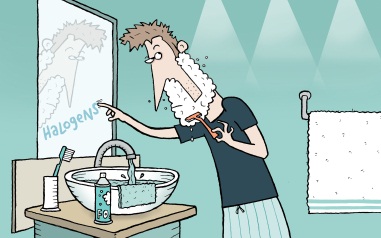
Lighting systems that are designed for halogen lamps now will have to be retrofitted with LEDs further down the line. It’s high time we started designing for LEDs from the ground up blogs Iain Ruxton
Last week, I stayed in a very cool boutique hotel in a Scandinavian capital city. It was, I must admit, rather lovely and luxurious. All the gadgets – big TV with an Android tablet to control it, great coffee machine, fast internet, I could even easily make sense of the lighting control (see opinion page passim, as Private Eye would say). Cool but timeless décor, fabulous pillowage, rain shower… all the trimmings that come with this kind of place. All shiny and new… it’s only been open a couple of months or so.
But what about the lighting? Well, pretty nice design. Looked and felt good. A female colleague noted the bathroom was a bit dim for doing makeup and, with that opinion in mind, I looked again – I’ll admit a good shave would have been tricky. But hey, I don’t shave much. Maybe I’m officially cool. Or just scruffy.
What shocked us was the quantity of filaments in the place. There were LEDs too, but there was a lot of tungsten-halogen MR16. In a hotel in a European capital that opened this year?
Does this represent a lack of know-how on the part of the designers? Or a lack of budget? What’s the long-term plan, if there is one? Has the project been specified with the intention that all the halogen will be re-lamped with retrofit LED when the time comes? Is the assumption that retrofit LED lamps in MR16 and other small form-factors will represent a genuine replacement by then? That they will be able to deliver the same amount of light, the same look and feel, the same controllability in high-end, super-cool, luxury hotel rooms, restaurant, bar and lobby spaces? I’m not suggesting LED as a technology can’t deliver the required light, but in retrofit form on existing controls?
We all know there are credible retrofits around, but we also know they aren’t as good as an LED fixture designed from the ground up, based around a good module system or created as a peak design. In small form-factors, it’s very hard to fit in enough LEDs to generate the required output, enough thermal management to sink the heat and good enough drive electronics to dim smoothly on existing control systems. It’s extra-hard to make all of it of sufficiently high quality to actually deliver the longevity and efficiency that should constitute the big positives of LED.
There is no doubt there is a vast market for retrofits – the global installed base of halogen and conventional tungsten is mind-bogglingly massive and most users won’t want to immediately rip out and replace entire installations when the lamps get phased out in their country. It is essential to these users – and hugely profitable to the lamp manufacturers – that good retrofit LED solutions continue to be brought to market.
In the long term however, surely retrofits are an intermediate stage? Albeit one that may last a long time, especially in domestic settings. Isn’t it slightly disturbing to see commercial projects being designed and built now that rely on making a retrofit-based compromise later, rather than maximising the benefits of LED by designing for LED from the ground up?





